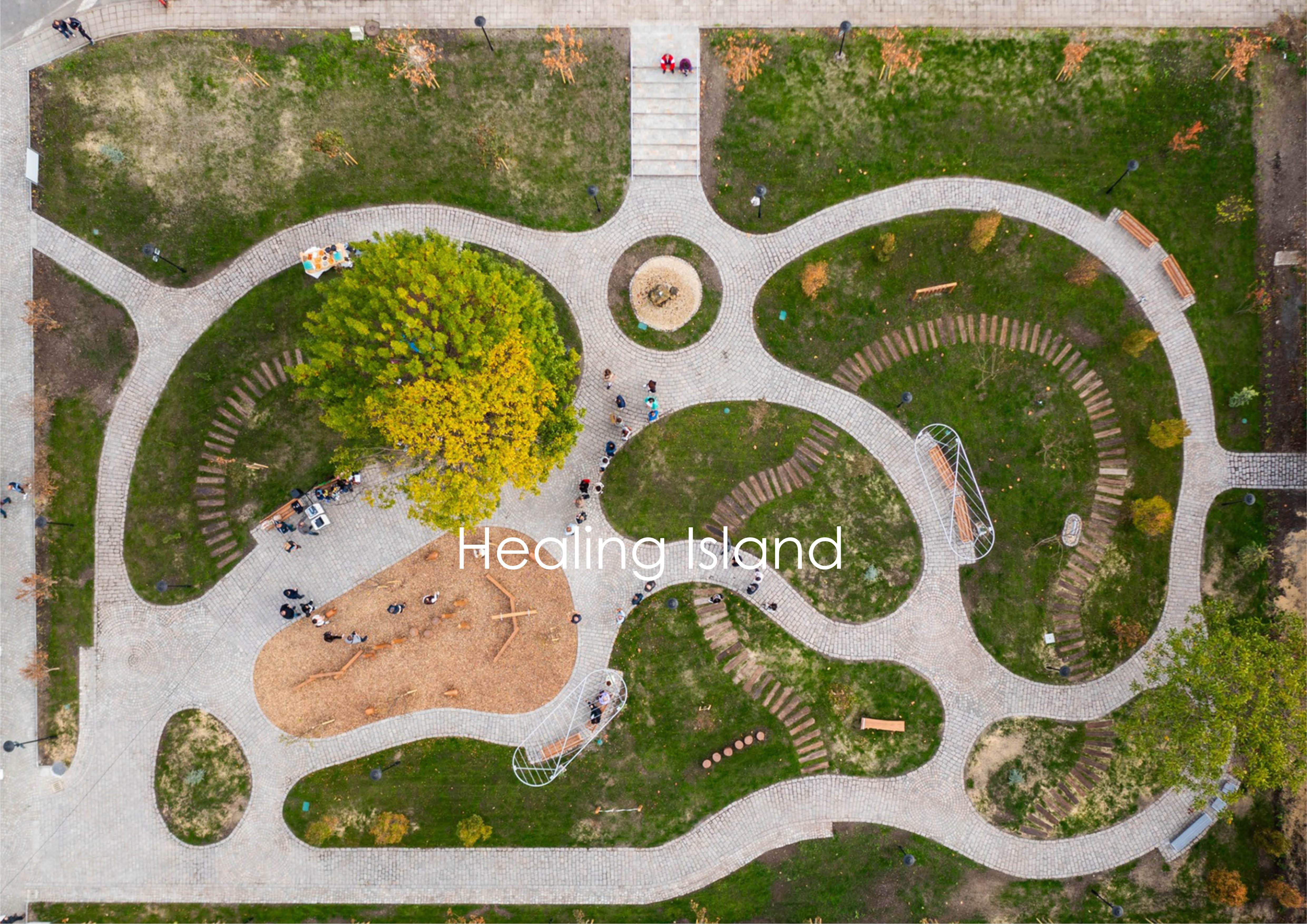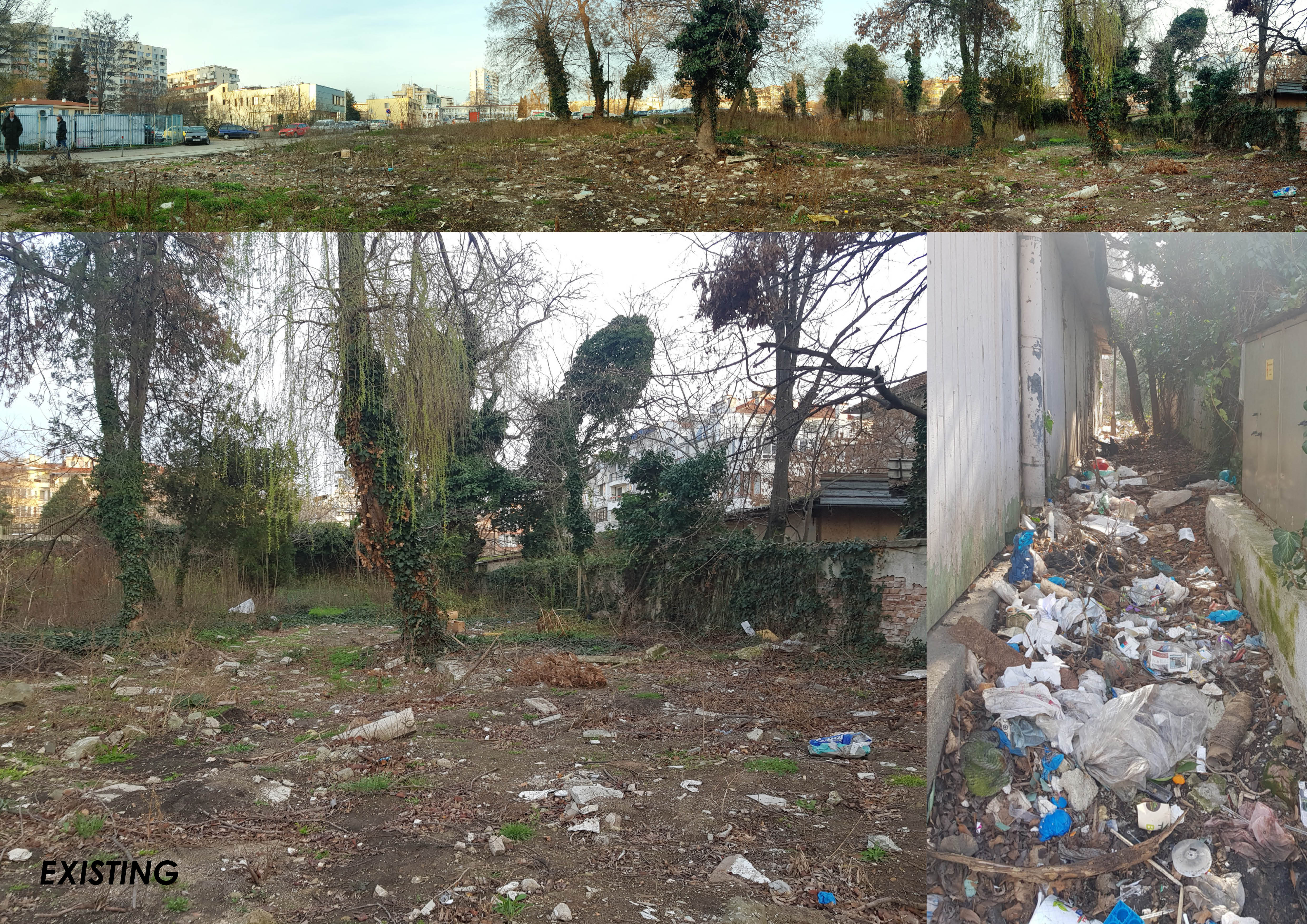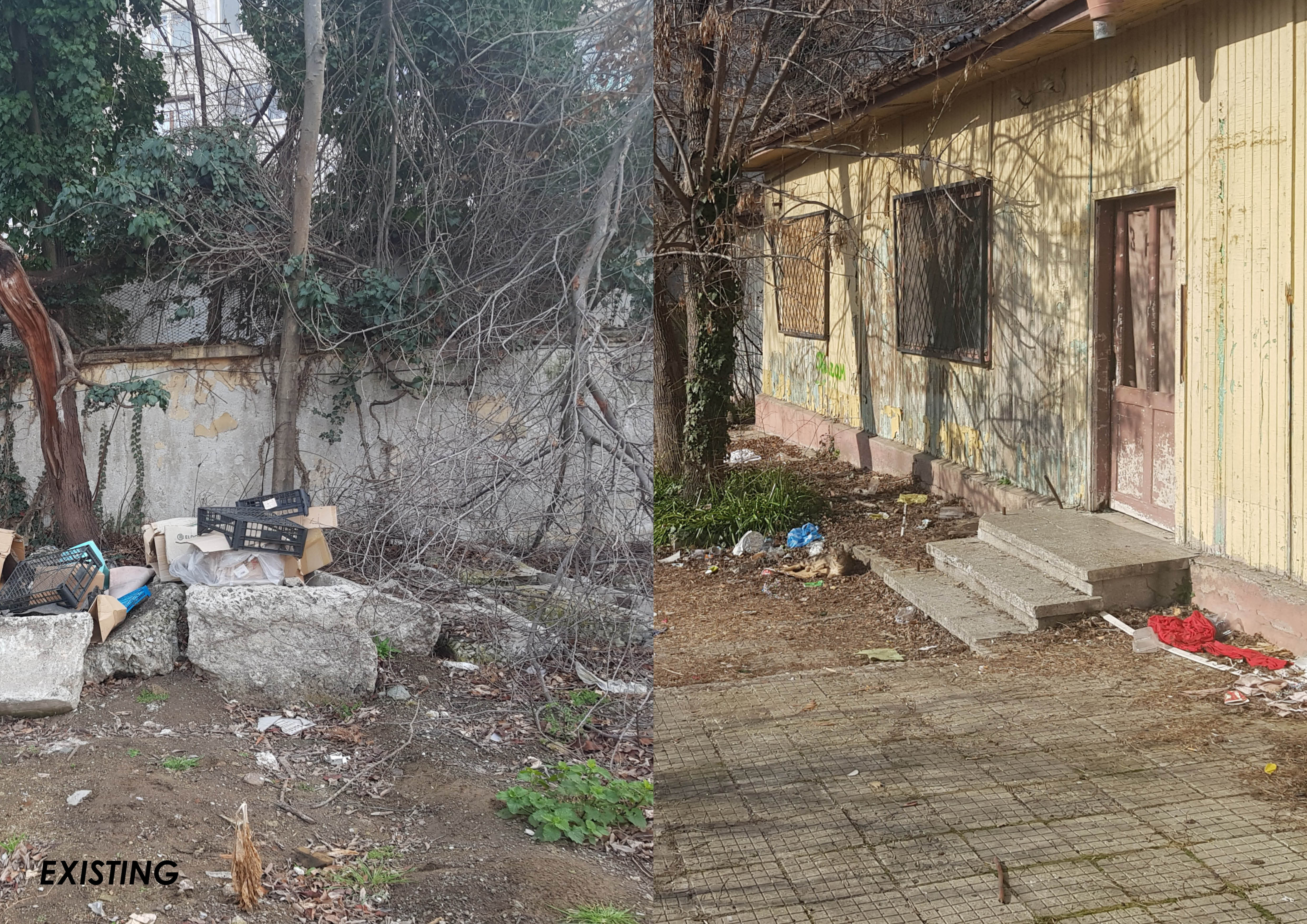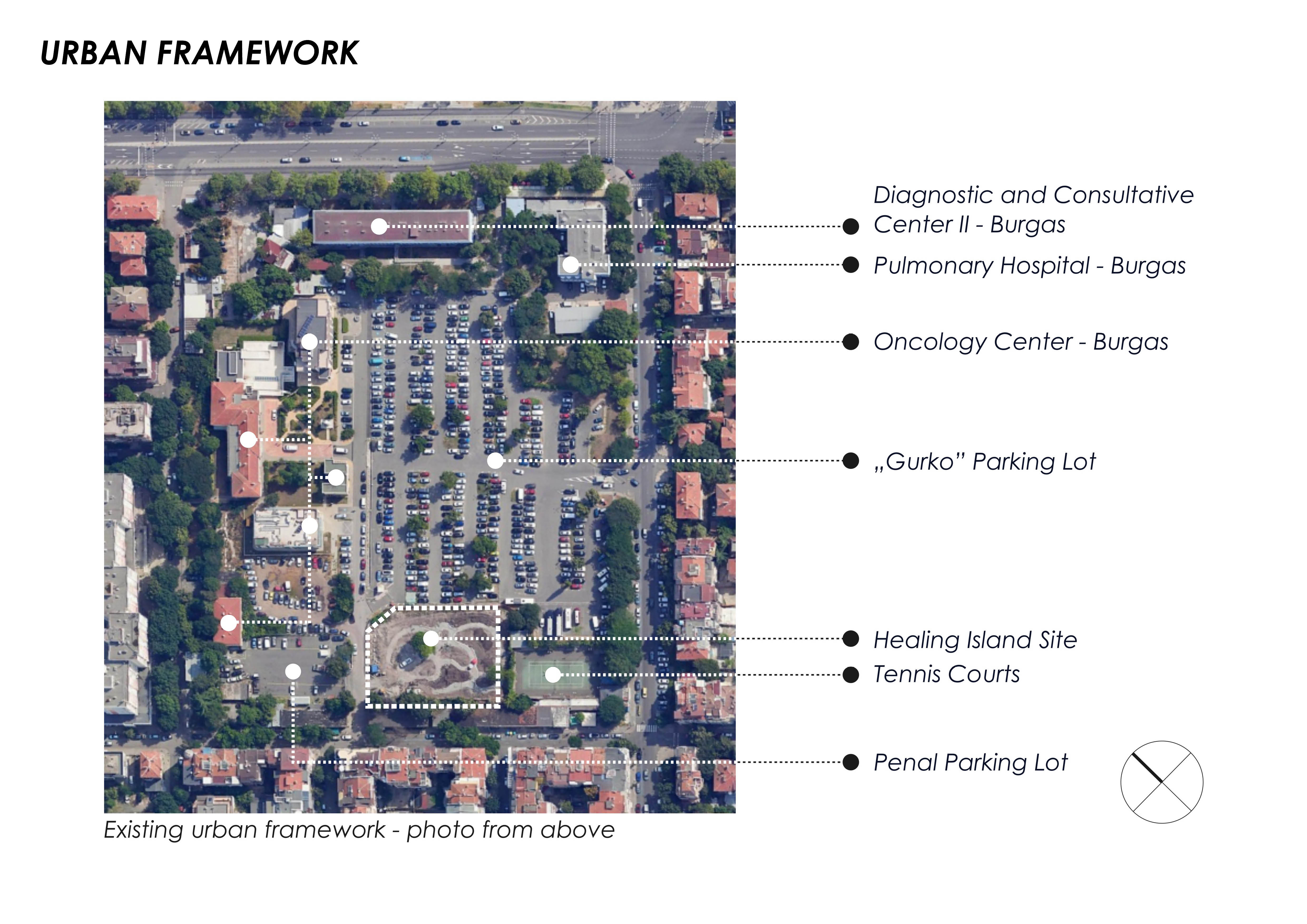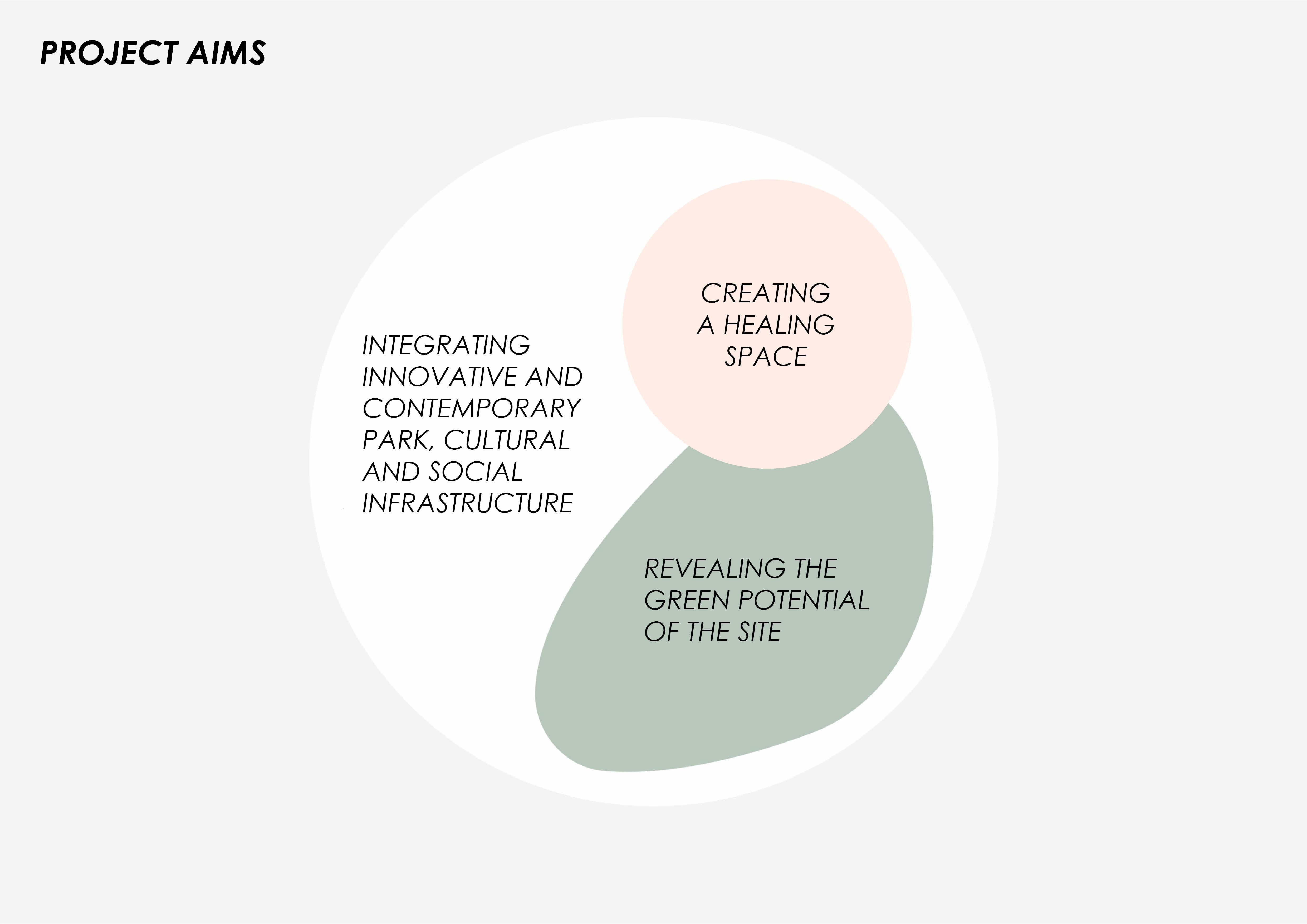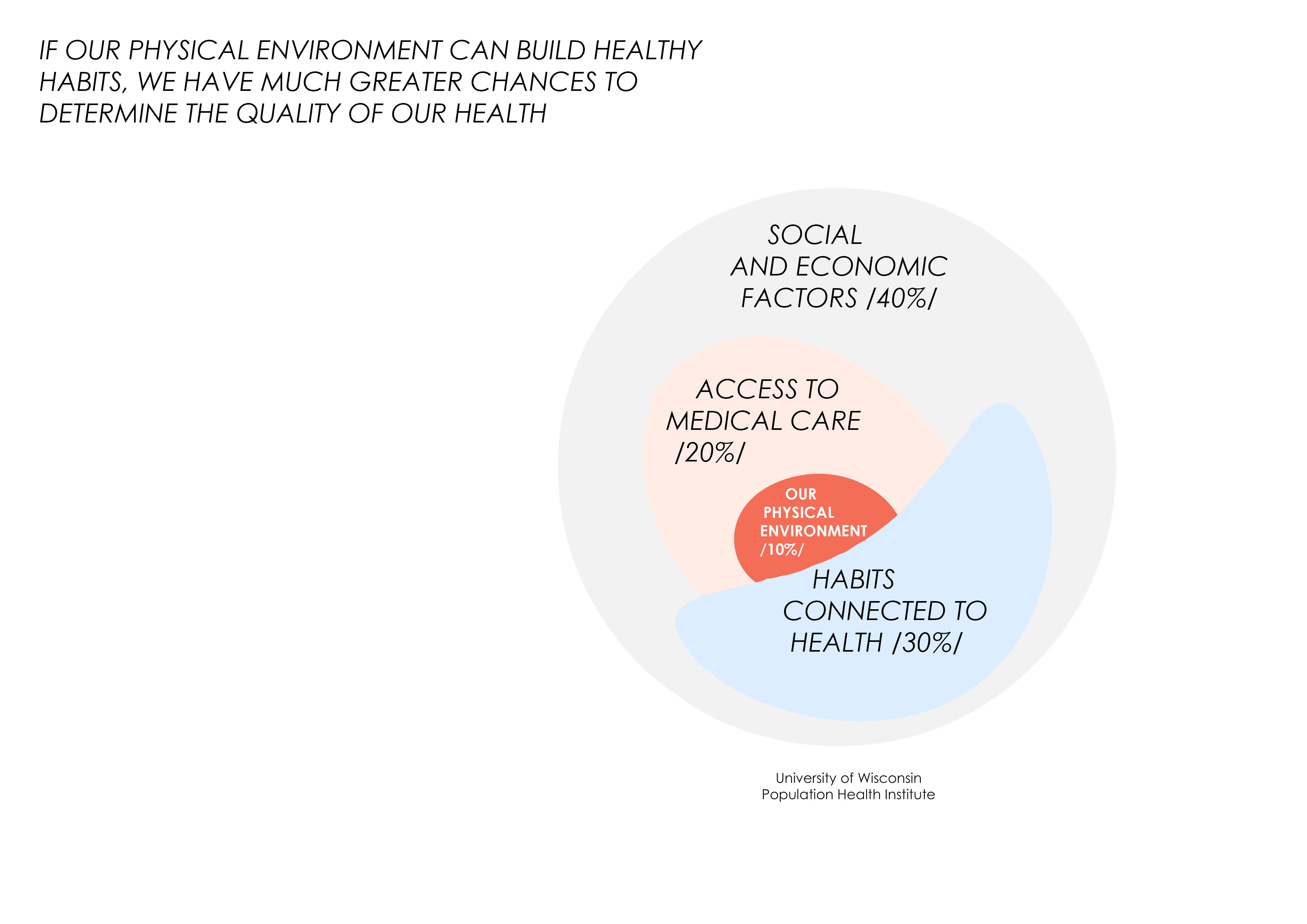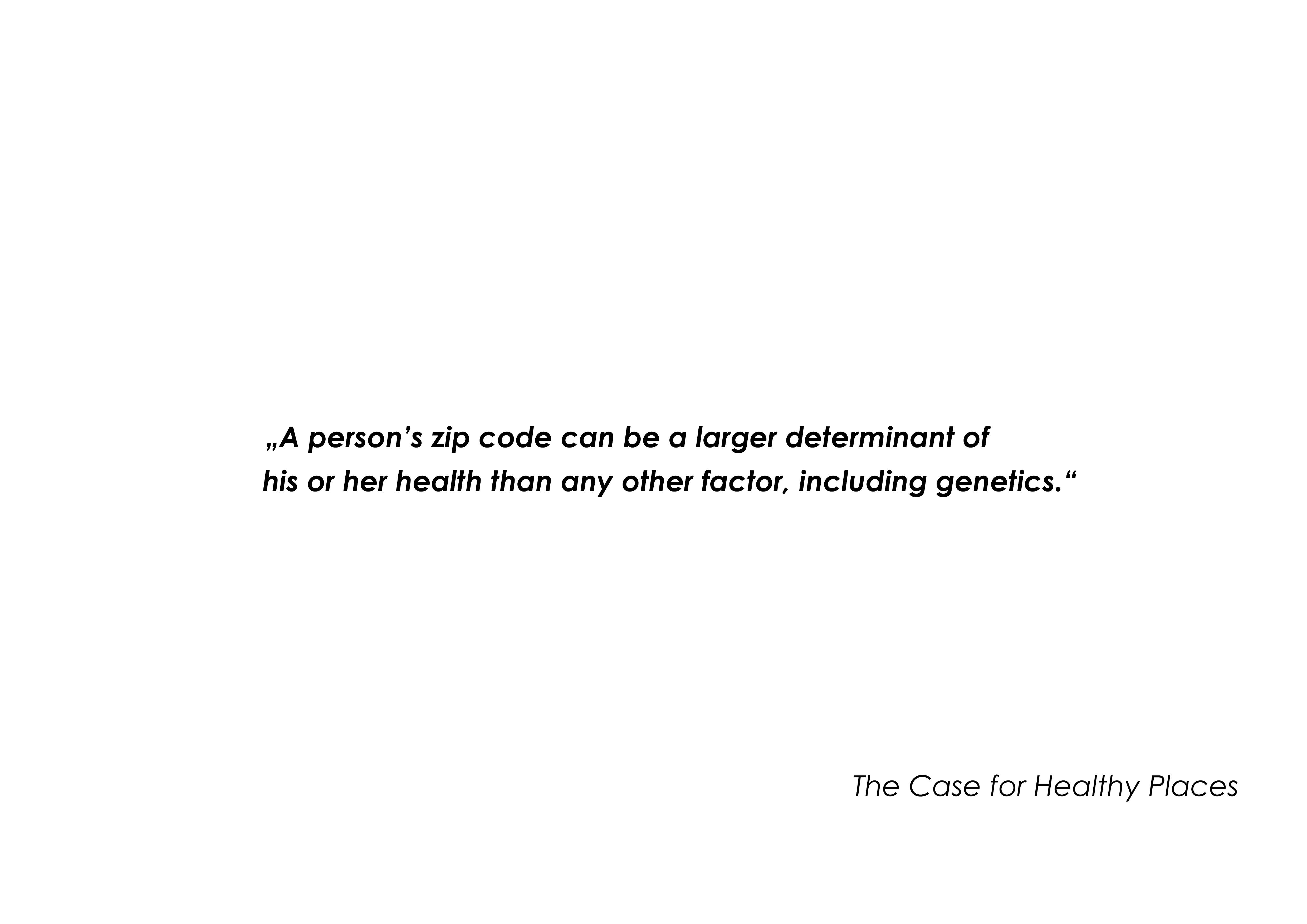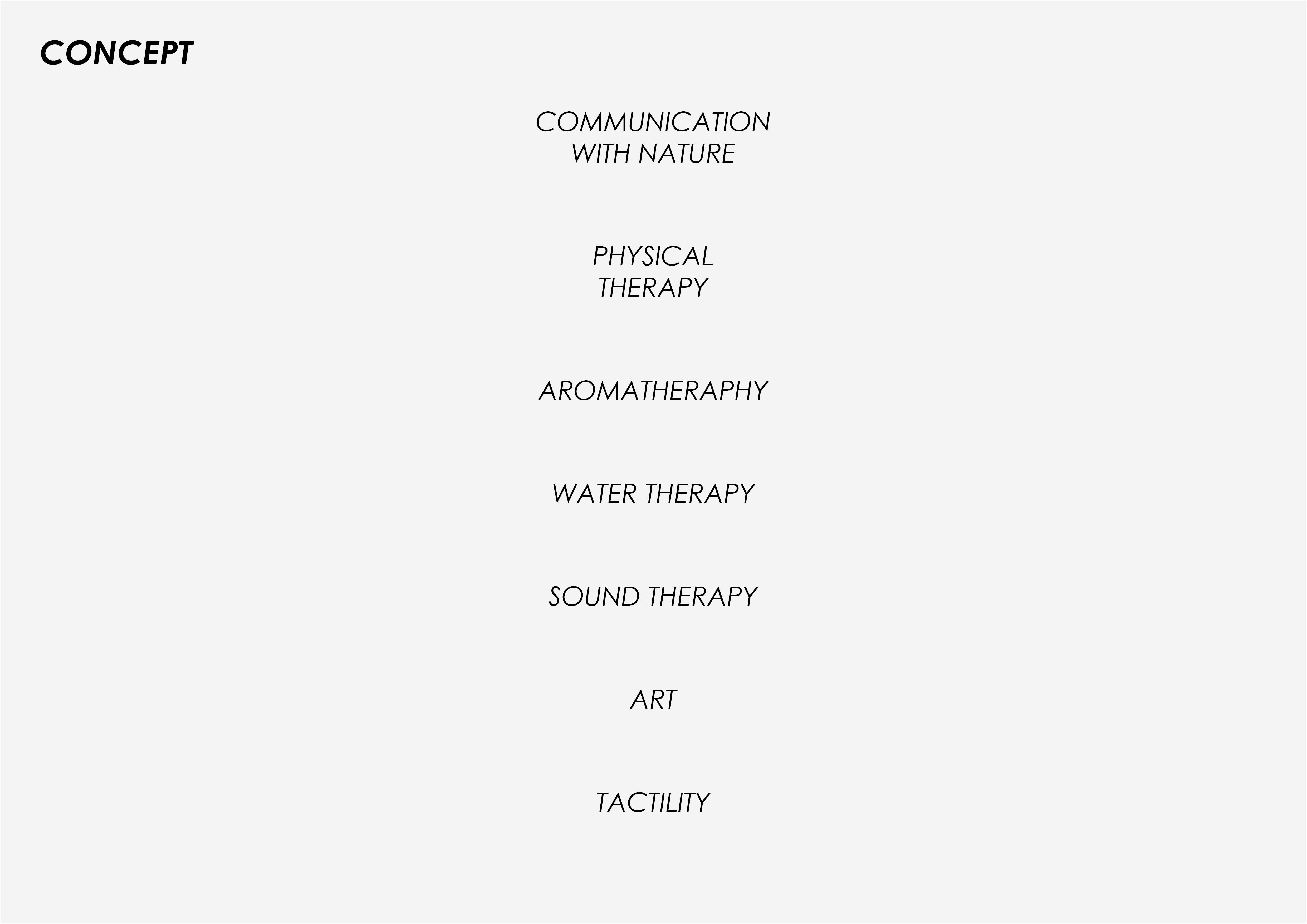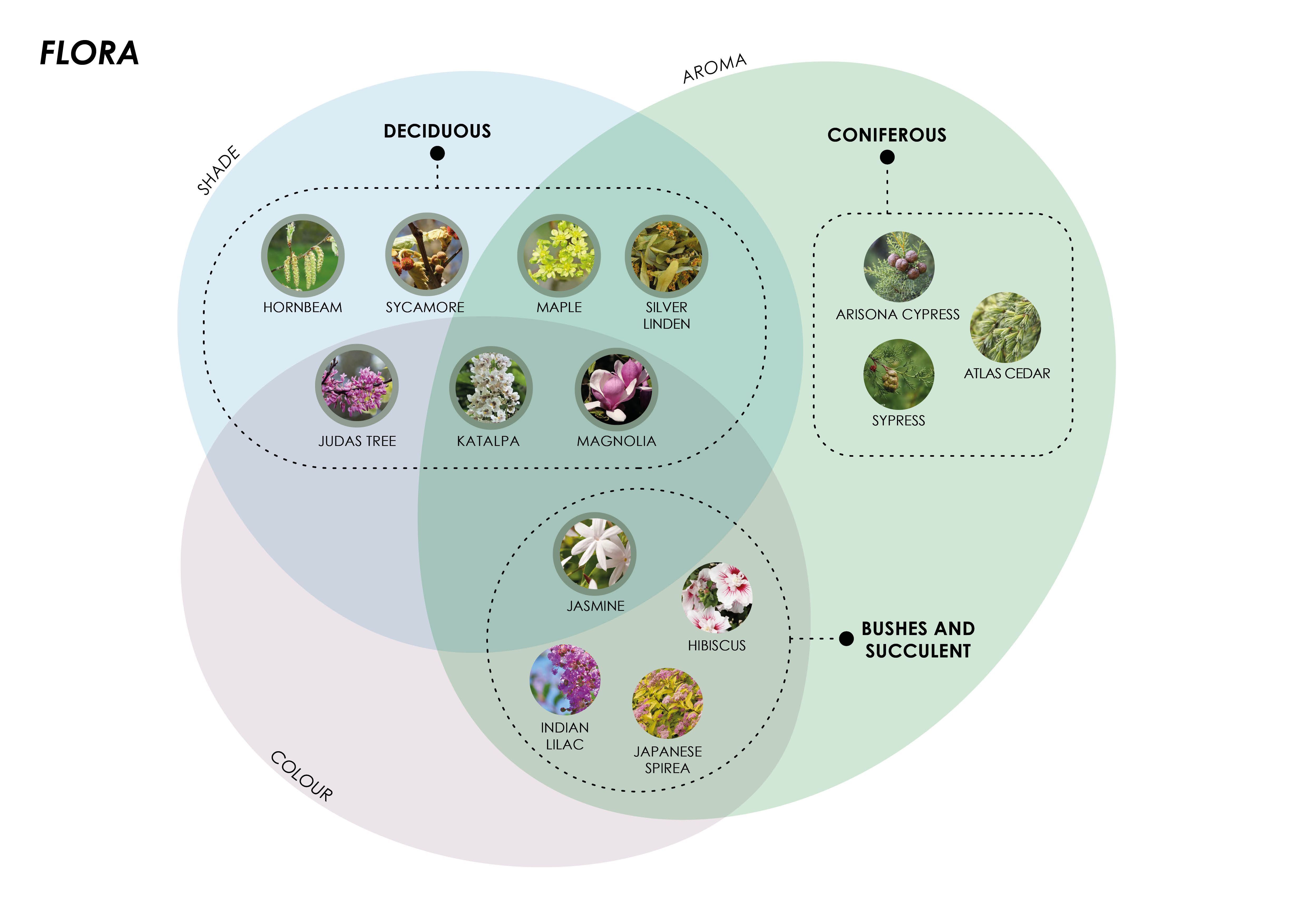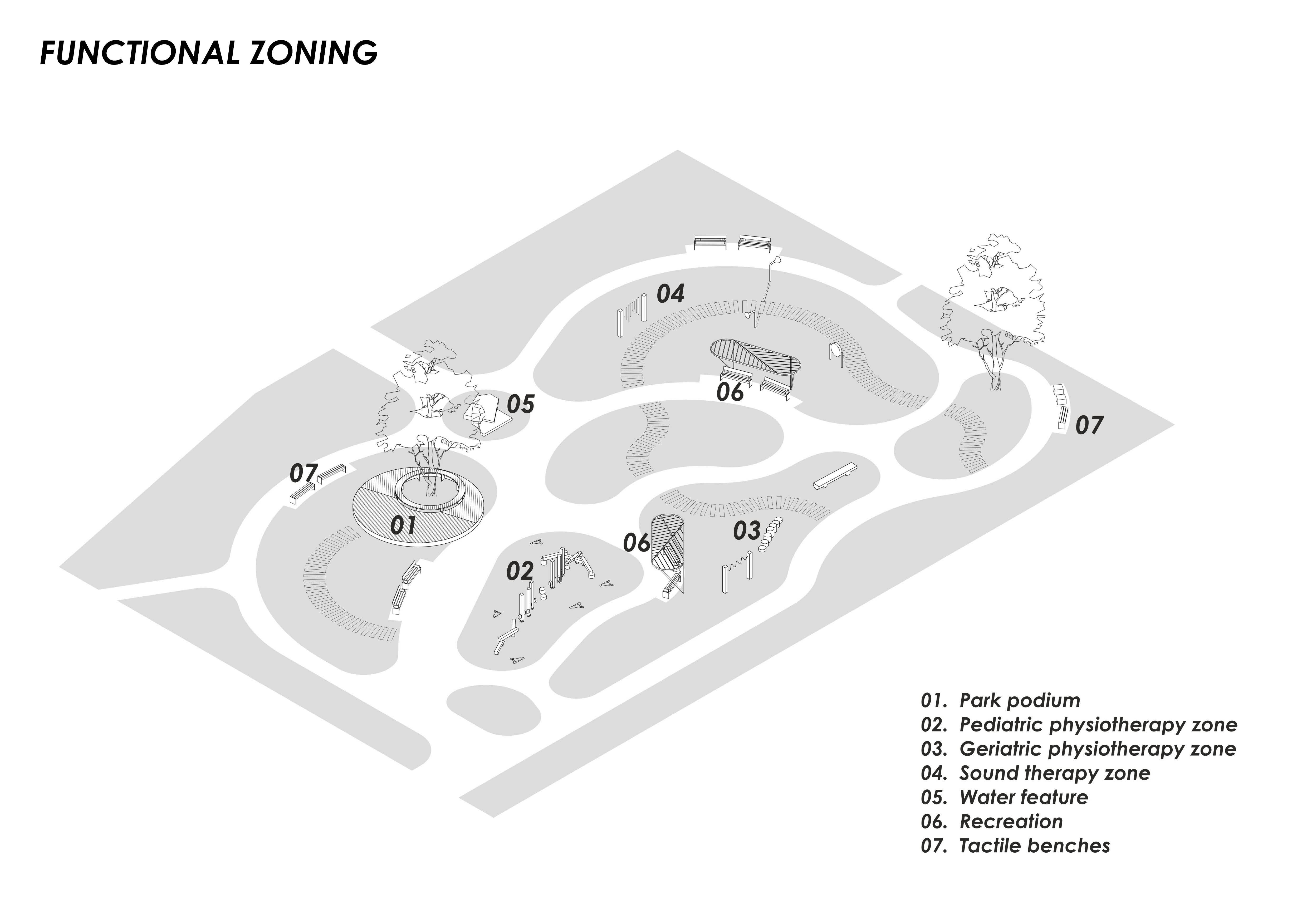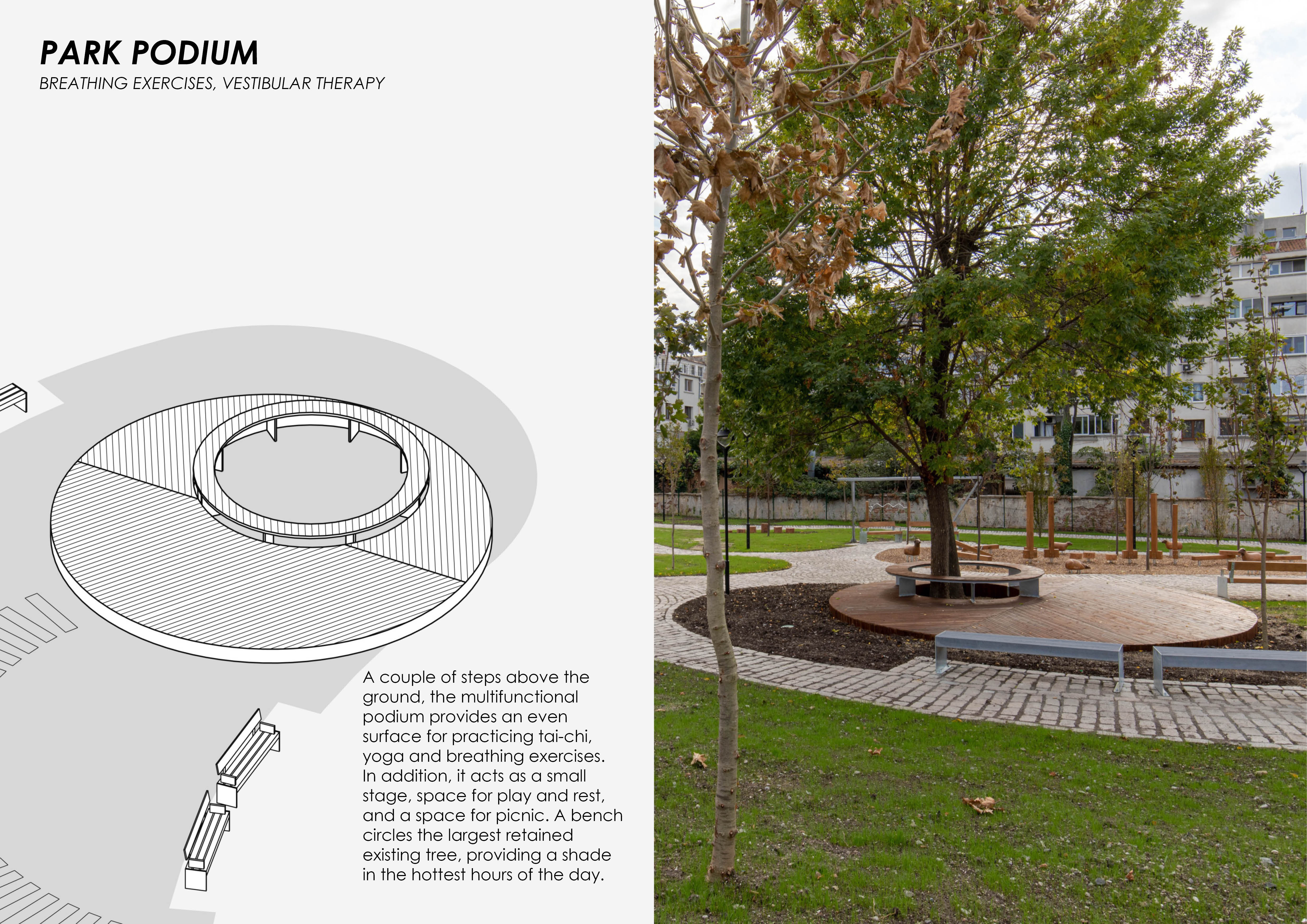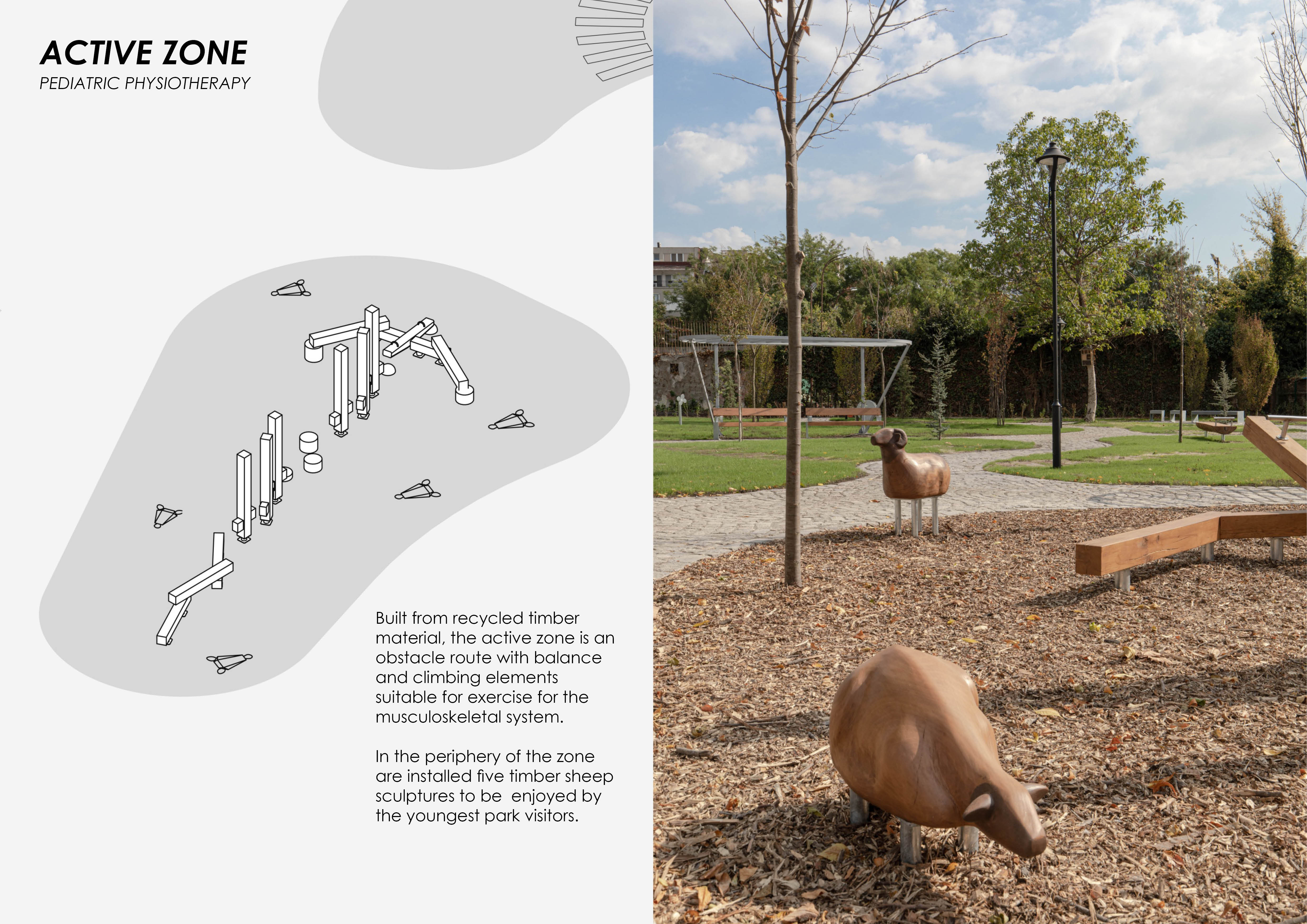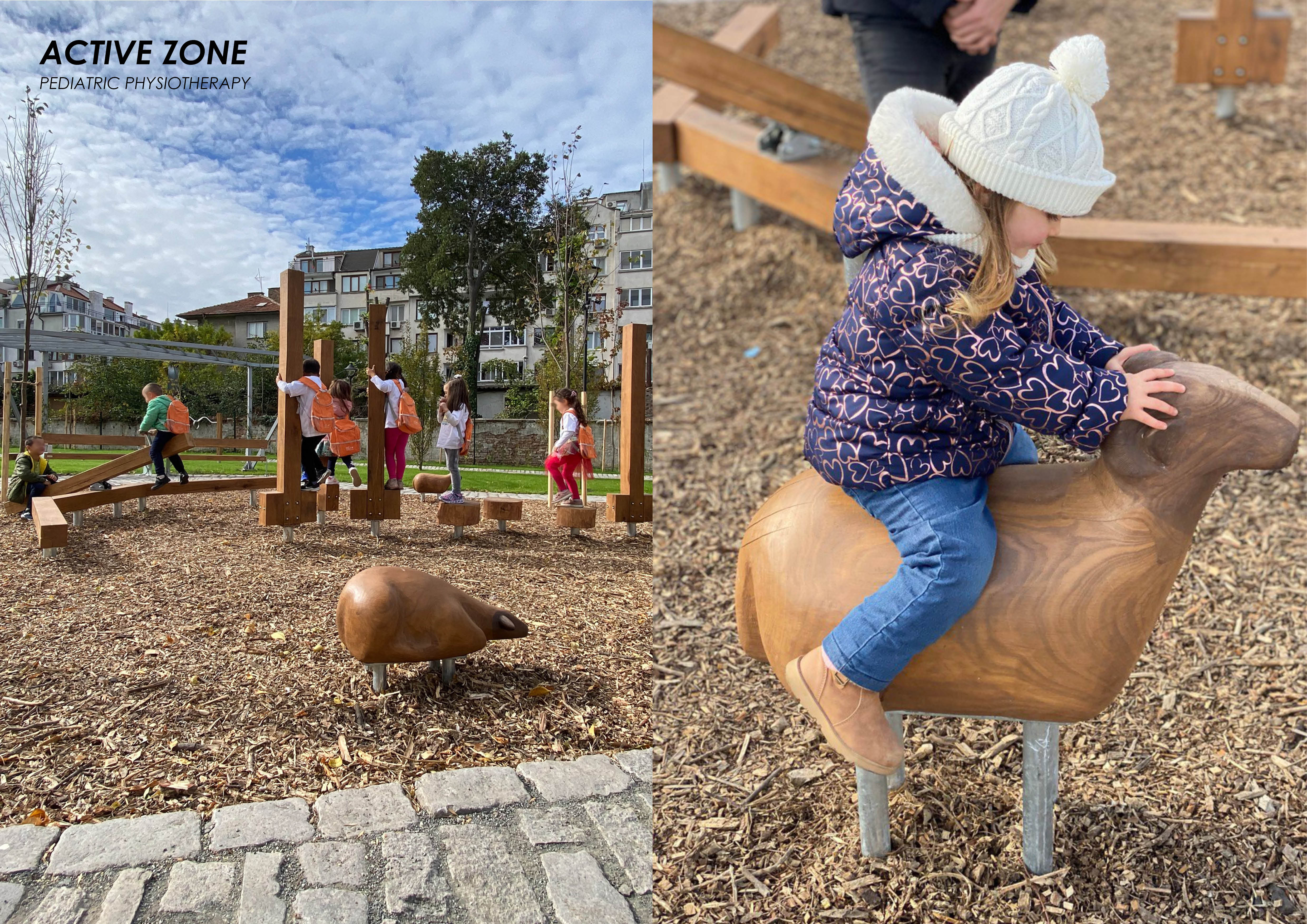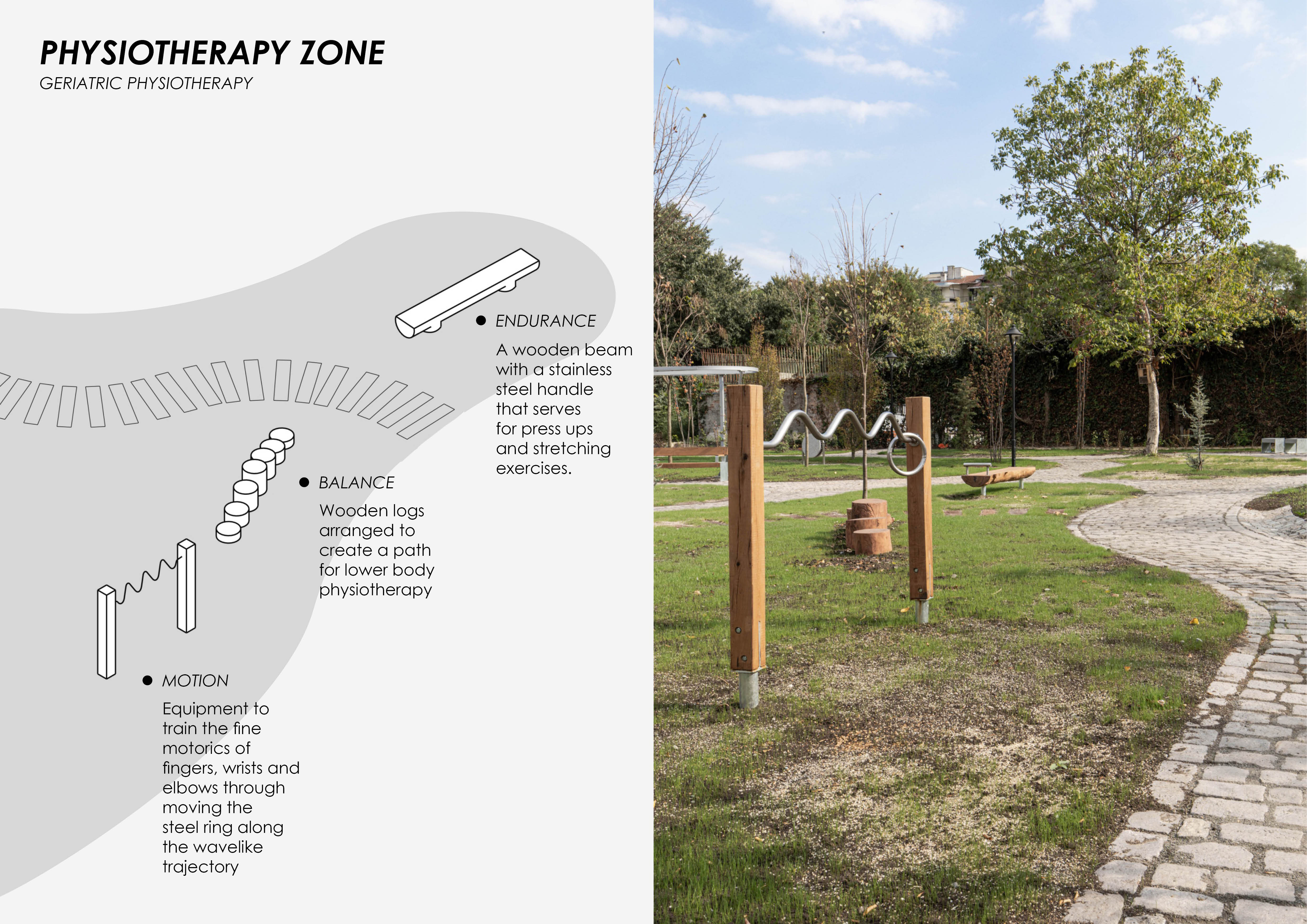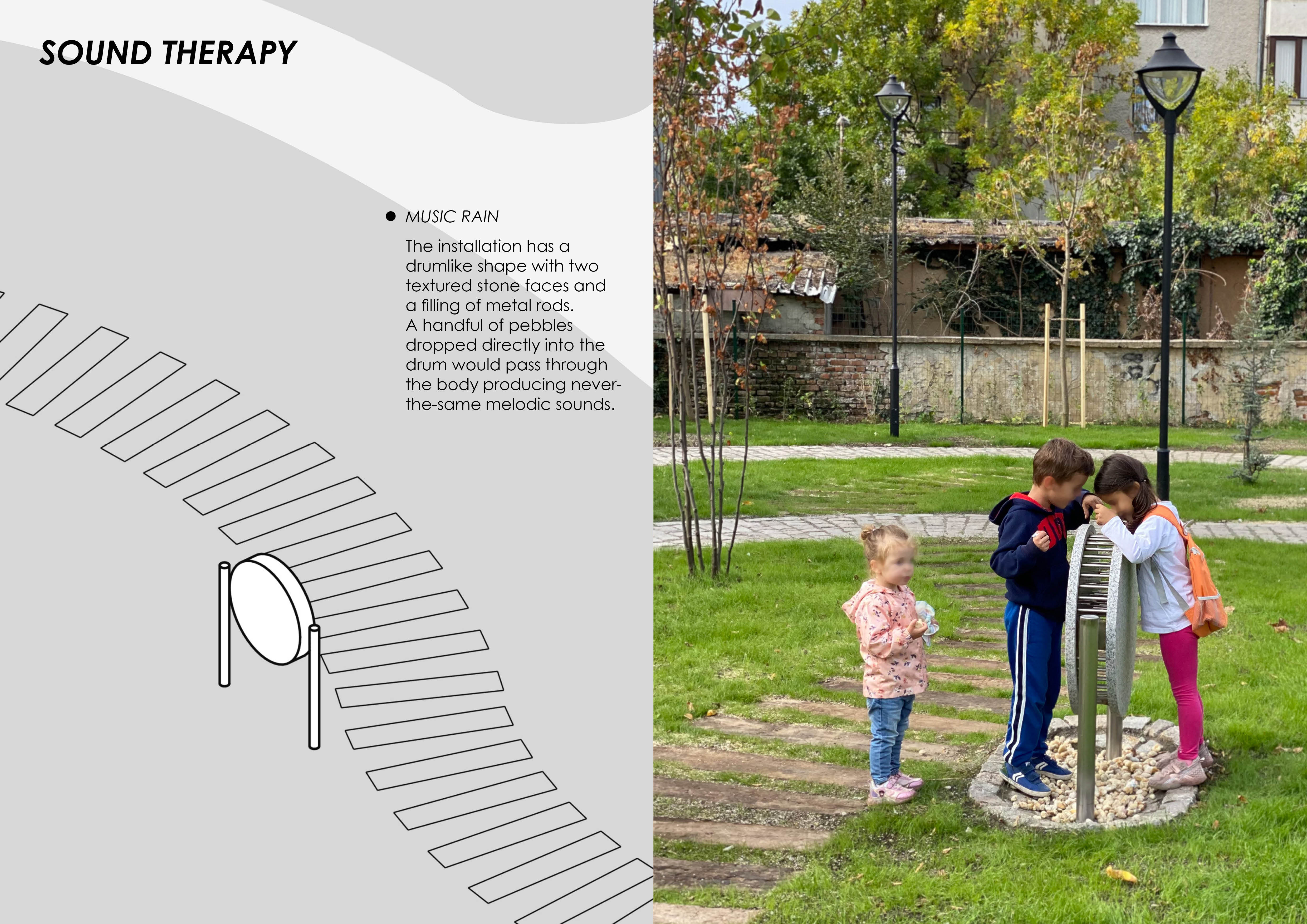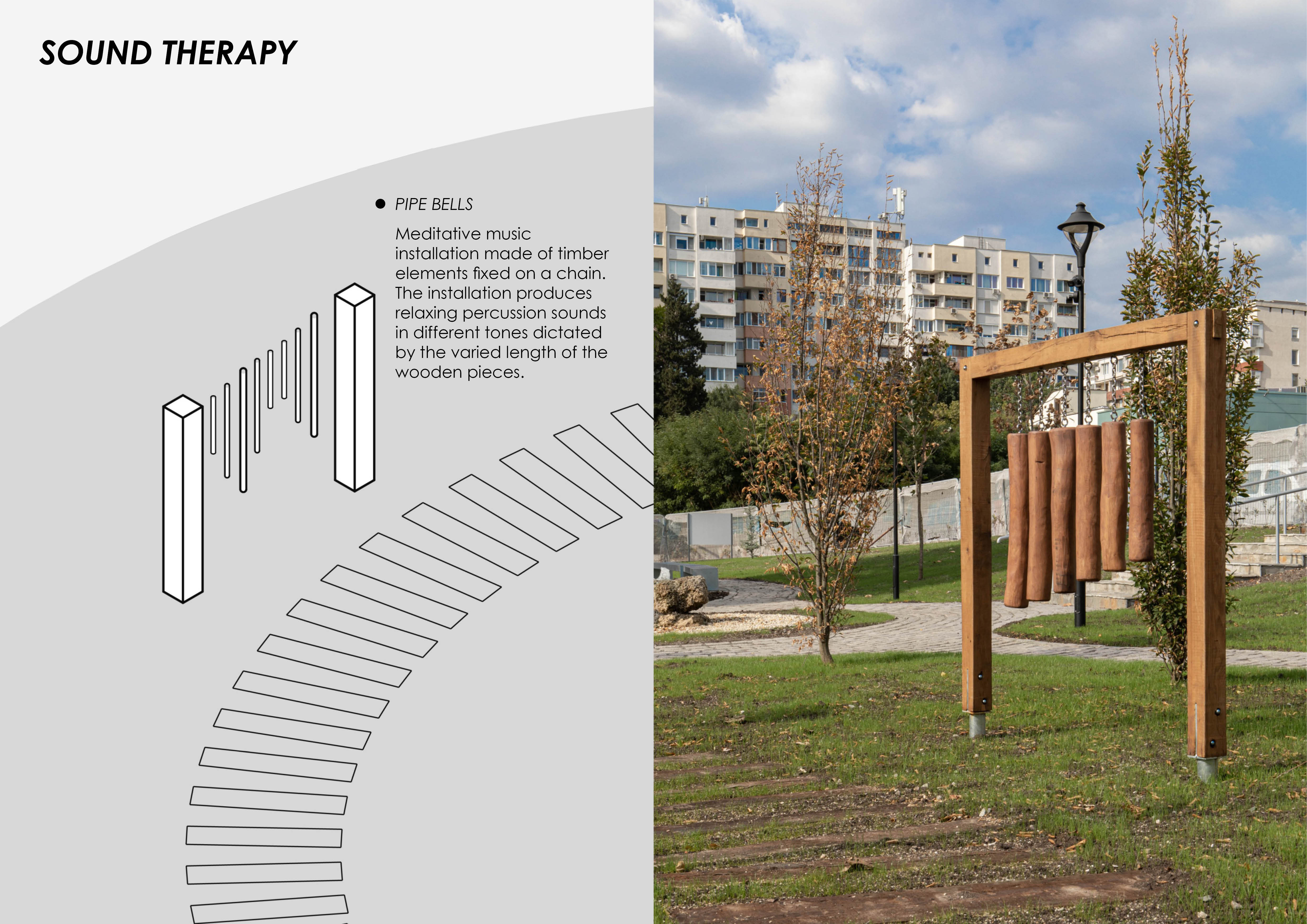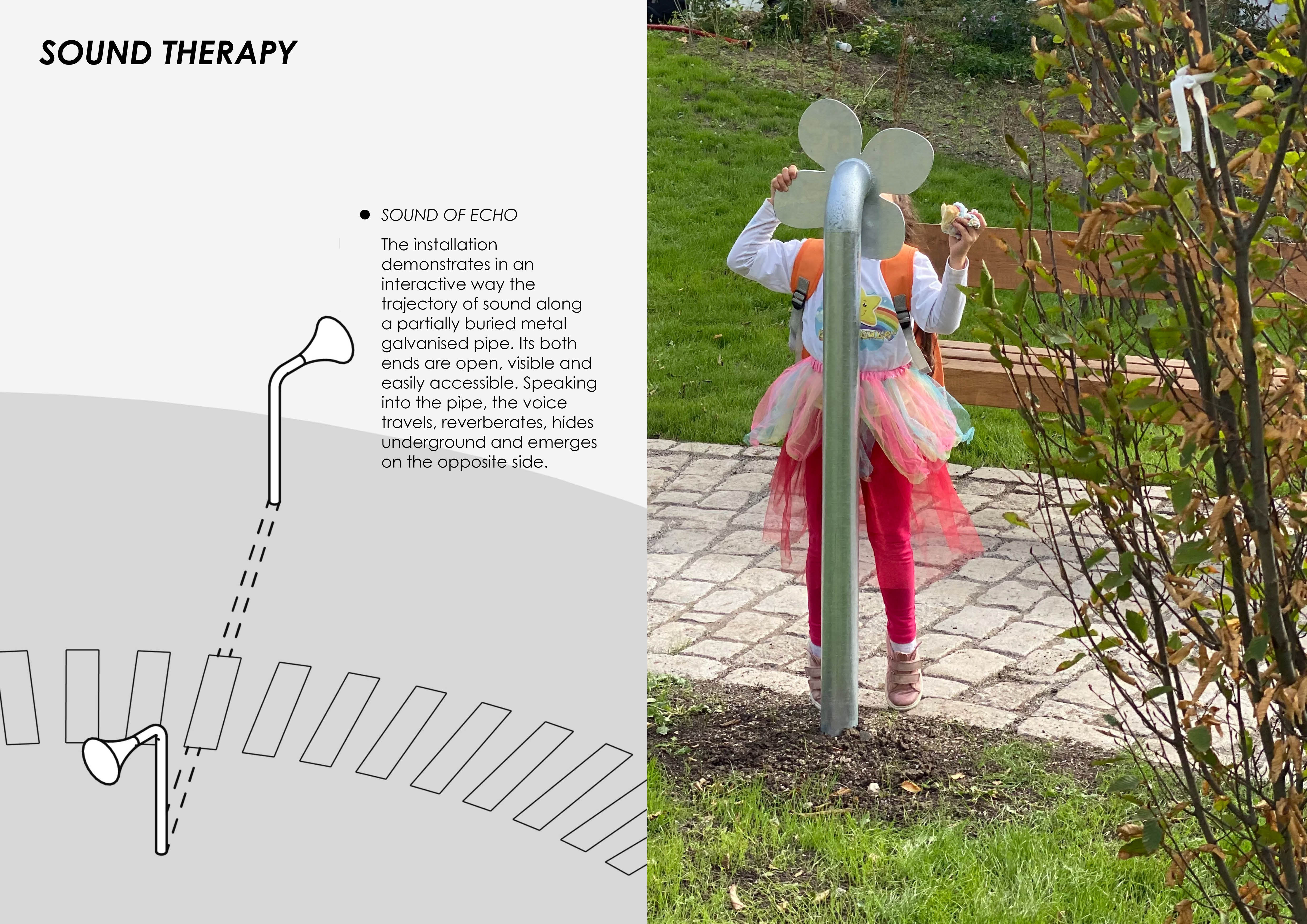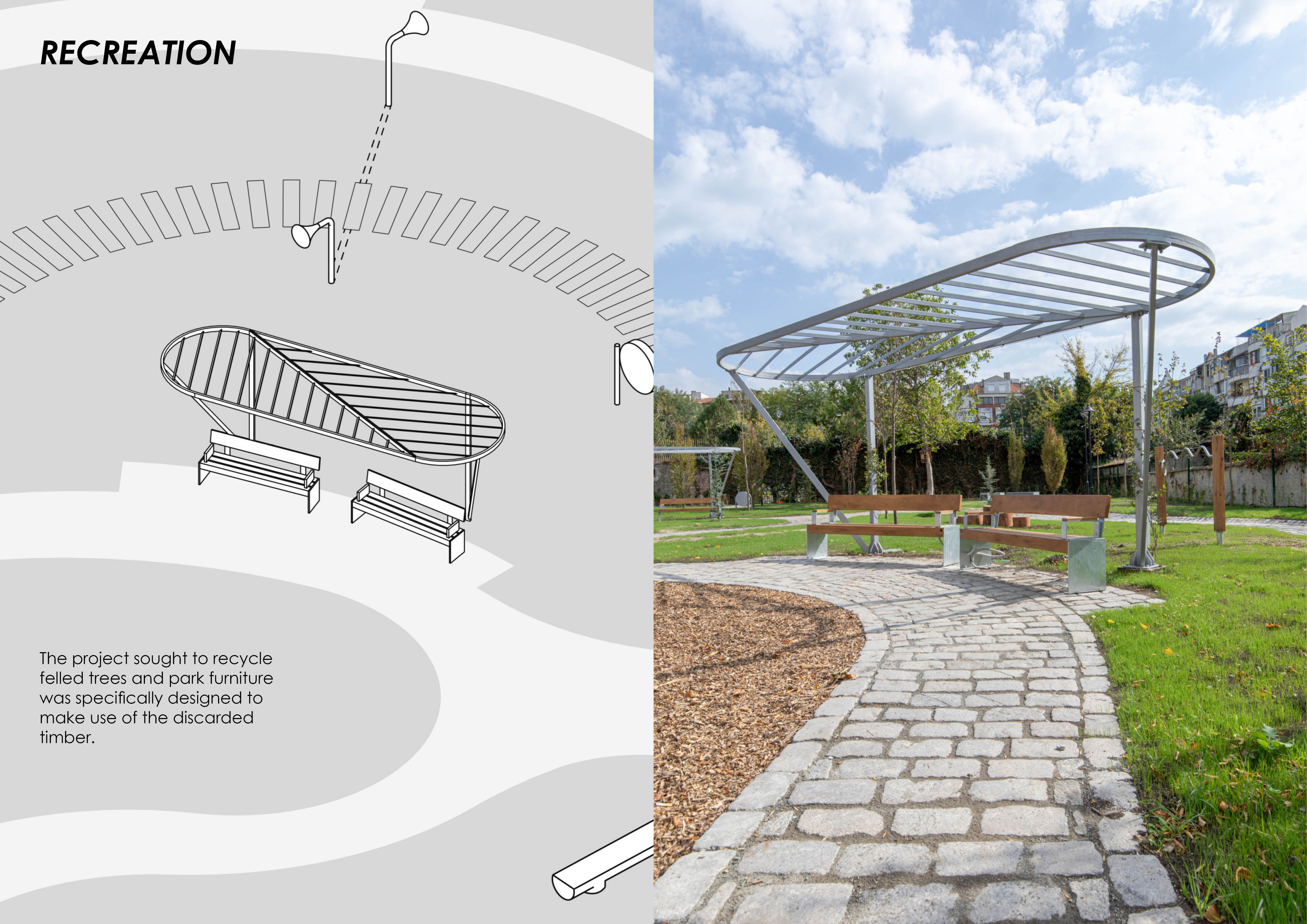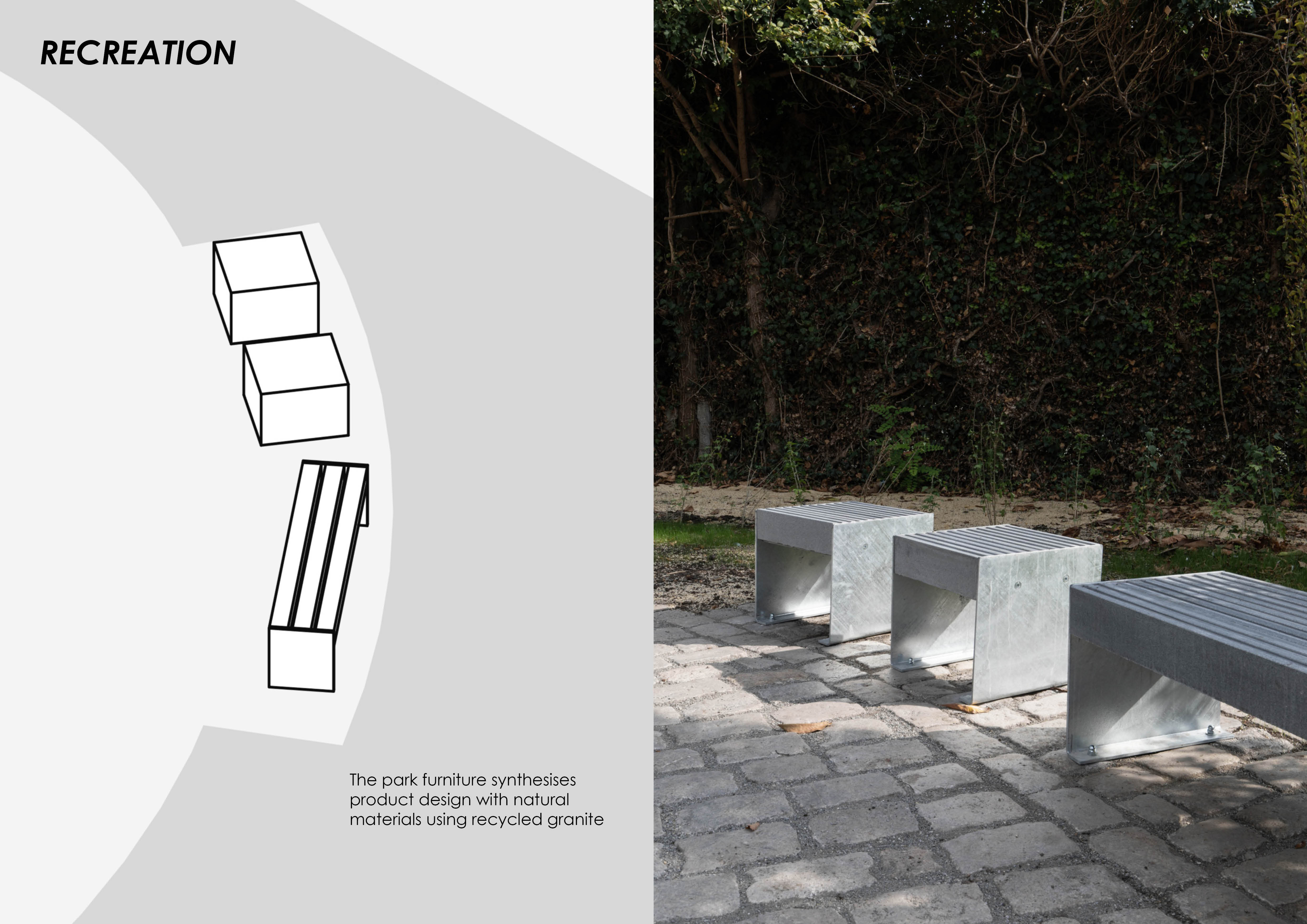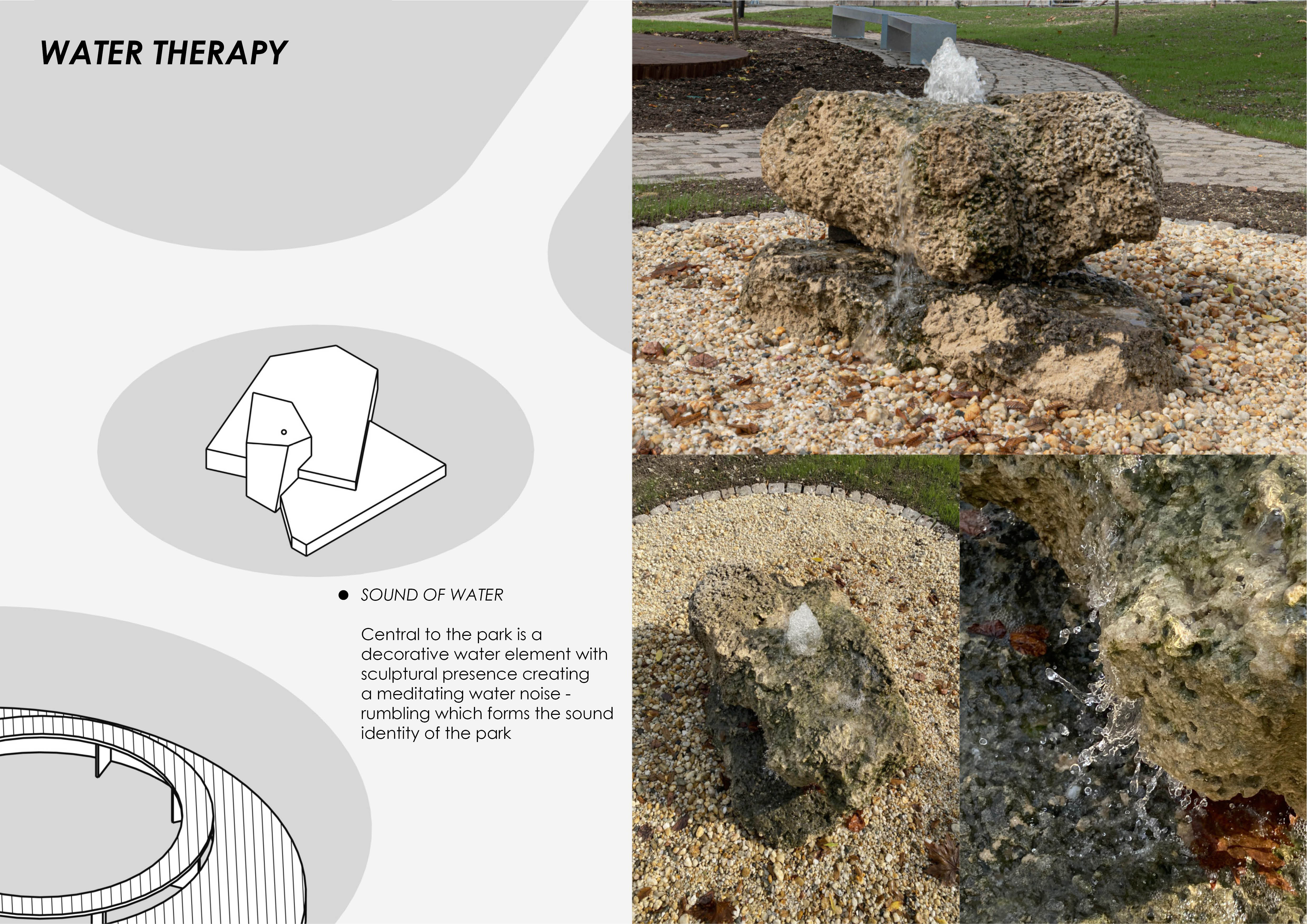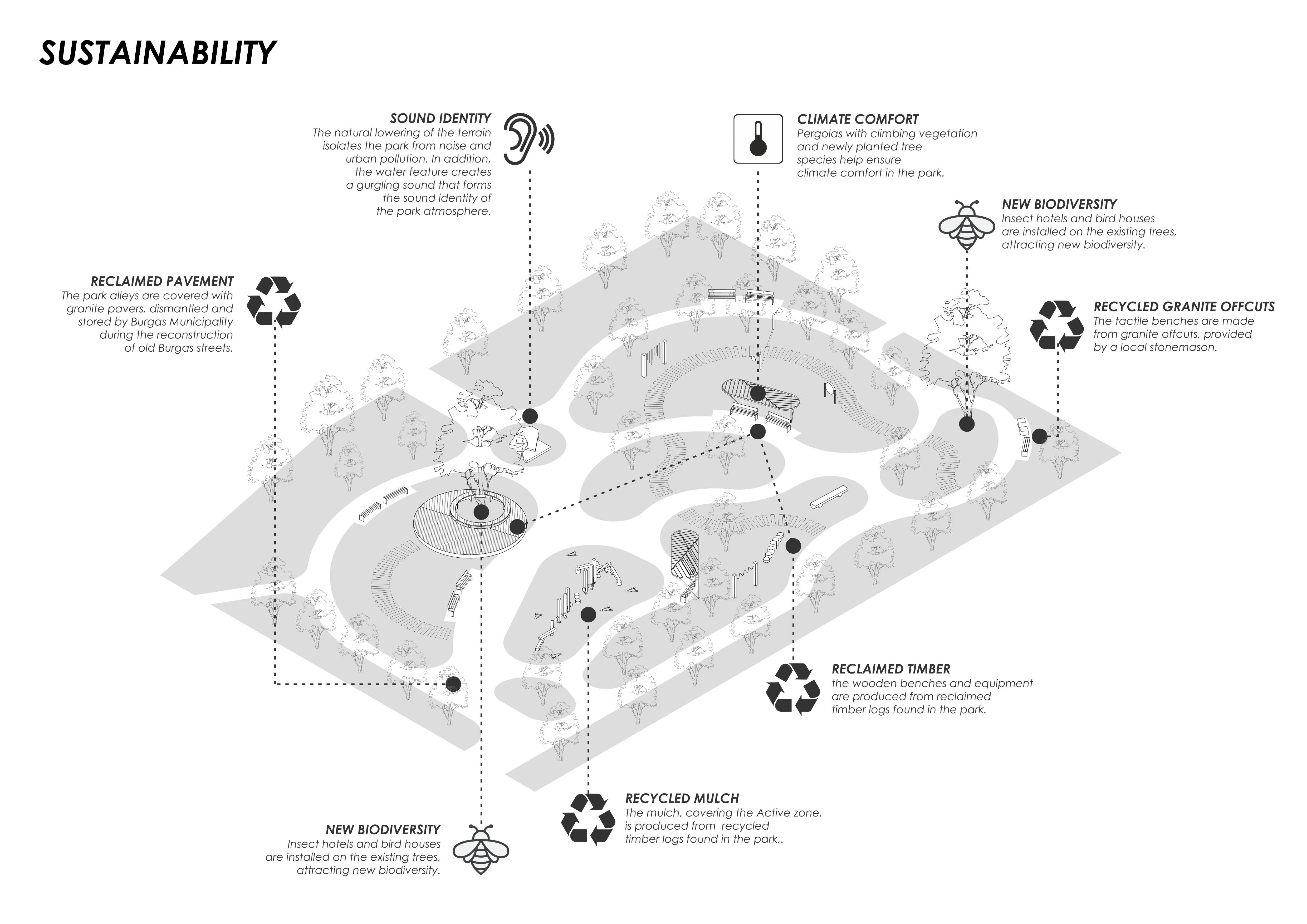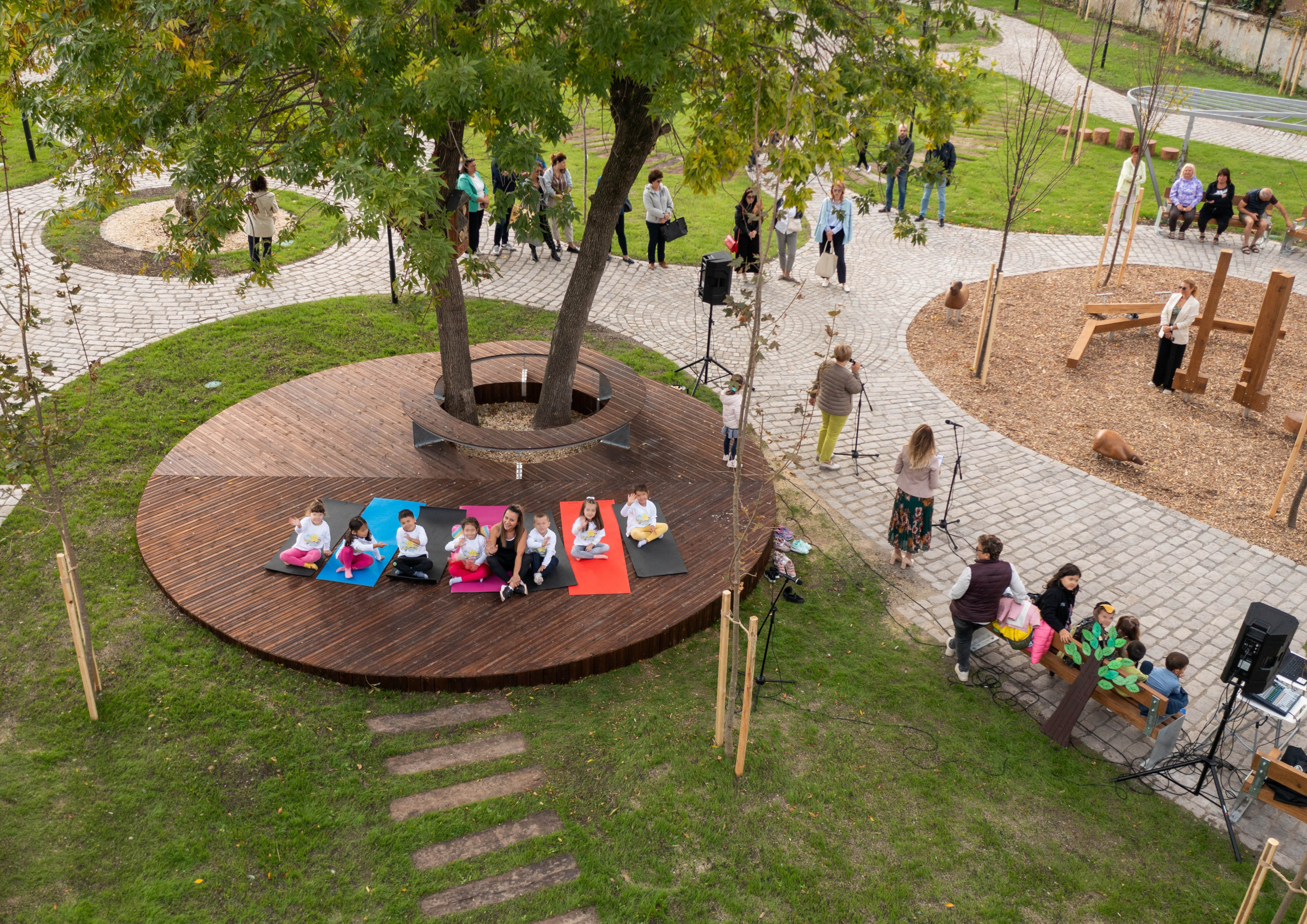Reconnecting with nature
Healing Island
A healthy park-island in which every element of the environment has a healing purpose
Healing Island is a project for the renovation of a hidden neglected green space located adjacent three of the most significant hospitals in Burgas, Bulgaria. For the annual traffic of 250 000 citizens, patients and their visitors, the new space uses recycled materials to provide an improved green environment, physiotherapy and emotional therapy zones, tactile park furniture made of natural materials, and solar infrastructure feeding into the lighting and the irrigation.
Bulgaria
Local
Burgas
Mainly urban
It refers to a physical transformation of the built environment (hard investment)
Yes
2023-10-10
Yes
EEA and Norway Grants – Programme “Environment and Climate Change”
No
No
As a representative of an organisation, in partnership with other organisations
Characterised by withered and ill trees, overgrown vegetation, litter, rubbish, and disused hospital buildings fallen into disrepair, the site of the project was the largest green area in the administrative boundary of the city centre with recreational potential.
The aim of the project was threefold: to regenerate the green potential of the site; to create a healing space; to integrate an innovative contemporary park, cultural, and social infrastructure;
The project is specifically designed to be a healing park-island for citizens of all ages, for disease prevention, as well as for hospital facilities visitors, and especially for oncological patients and patients in remission. Designed as a healthy urban space where every element of the environment has a healing purpose, the park promotes healthy habits through communication with nature, aromatherapy, sound and water therapy, physiotherapy.
The project ensures all visitors’ physical and emotional wellbeing through a variety of equipment designed specifically for the project and site. Arranged in different Physiotherapy and Emotional therapy zones, the equipment also helps oncological patients strengthen their body and psyche, regain their ability to perform various movements, and improve their emotional state during on-going oncological treatment. The project pays attention to arts and natural materials, combining them in tactile park furniture designed with artistic value and implemented using sustainable practices.
The aim of the project was threefold: to regenerate the green potential of the site; to create a healing space; to integrate an innovative contemporary park, cultural, and social infrastructure;
The project is specifically designed to be a healing park-island for citizens of all ages, for disease prevention, as well as for hospital facilities visitors, and especially for oncological patients and patients in remission. Designed as a healthy urban space where every element of the environment has a healing purpose, the park promotes healthy habits through communication with nature, aromatherapy, sound and water therapy, physiotherapy.
The project ensures all visitors’ physical and emotional wellbeing through a variety of equipment designed specifically for the project and site. Arranged in different Physiotherapy and Emotional therapy zones, the equipment also helps oncological patients strengthen their body and psyche, regain their ability to perform various movements, and improve their emotional state during on-going oncological treatment. The project pays attention to arts and natural materials, combining them in tactile park furniture designed with artistic value and implemented using sustainable practices.
Urban renovation
Nature-based solution
Healthy habits
Disease prevention
Recycled materials
Since the outset, it has been the team’s aim to find ways to integrate sustainable solutions and benefit form them in as many aspects as possible.
The park alleys covered with granite pavers create a feeling of familiarity, being the same reused pavers that were dismantled and stored by Burgas Municipality during the reconstruction of old Burgas streets. The porous material fit readily with the park’s concept for natural materials and proved to be suitable for modelling the surface for water runoff. It was also laid by hand and the number and size of the available blocks predetermined the laying methods which created a unique geometric pattern, also reducing the need for heavy machinery.
The condition of the existing trees required the felling of many of them, however the material was sorted and its bark was shredded to become the mulch covering the Active Zone, while the wooden benches and equipment in the park were produced from the reclaimed timber logs.
The provision of water in public spaces is common in Bulgaria, and in this project stone pieces provided by the contractor from the excavation of a local construction site were used in the water feature. Bringing new bird, insect and plant species, the feature has been developing into a new micro ecosystem since arriving on-site.
The tactile presence of the granite benches is a design feature rooted in the sourcing of the material: the design was specifically developed to make use of small-scale offcuts provided by a local stonemason.
The park alleys covered with granite pavers create a feeling of familiarity, being the same reused pavers that were dismantled and stored by Burgas Municipality during the reconstruction of old Burgas streets. The porous material fit readily with the park’s concept for natural materials and proved to be suitable for modelling the surface for water runoff. It was also laid by hand and the number and size of the available blocks predetermined the laying methods which created a unique geometric pattern, also reducing the need for heavy machinery.
The condition of the existing trees required the felling of many of them, however the material was sorted and its bark was shredded to become the mulch covering the Active Zone, while the wooden benches and equipment in the park were produced from the reclaimed timber logs.
The provision of water in public spaces is common in Bulgaria, and in this project stone pieces provided by the contractor from the excavation of a local construction site were used in the water feature. Bringing new bird, insect and plant species, the feature has been developing into a new micro ecosystem since arriving on-site.
The tactile presence of the granite benches is a design feature rooted in the sourcing of the material: the design was specifically developed to make use of small-scale offcuts provided by a local stonemason.
The project considers the oncological treatment as a multi-level process which can be introduced into the daily life and habits of all park visitors, creating an aesthetic environment which can be contributing to the processes of disease curing, recovery, regaining one’s ability to perform various movements, strengthening the body and the psyche.
A variety of equipment situated in the natural park environment ensures the execution of these treatment steps, as well as breathing exercises, physiotherapy, yoga, tai-chi, coordination and balance exercises, movement, muscles and joints strengthening.
The facilities include:
• The park podium provides area for yoga, tai chi, breathing exercises, vestibular therapy. In addition, it serves as a stage, a children's playground, a picnic area.
• The Physiotherapy Zone for balance and stretching includes timber equipment encouraging hospital patients and senior citizens’ mobility and physical activity.
• The Active Zone consists of climbing and balancing timber elements, suitable for exercising children’ and adults’ musculoskeletal system. Five sheep sculptures are designed for the youngest visitors to play with.
A variety of equipment situated in the natural park environment ensures the execution of these treatment steps, as well as breathing exercises, physiotherapy, yoga, tai-chi, coordination and balance exercises, movement, muscles and joints strengthening.
The facilities include:
• The park podium provides area for yoga, tai chi, breathing exercises, vestibular therapy. In addition, it serves as a stage, a children's playground, a picnic area.
• The Physiotherapy Zone for balance and stretching includes timber equipment encouraging hospital patients and senior citizens’ mobility and physical activity.
• The Active Zone consists of climbing and balancing timber elements, suitable for exercising children’ and adults’ musculoskeletal system. Five sheep sculptures are designed for the youngest visitors to play with.
One of Healing Island’s achievements is its inclusivity and accessibility. The project equipment is health beneficial for all age groups. Inclusive benches and step-free sidewalks are provided for the disabled. The project considers not only physical wellbeing, but also pays attention to the emotional state of the visitors. Sound is a universal language which is understood by people of all ages, nationalities and transcends many physical differences. Music and water are used as an essential element for treating anxiety and depression.
In this regard, the park offers:
• The Music Rain installation resembling the shape of a flat drum clad with two slabs of textured granite with a core of thin metal elements. Whenever river pebbles pass through the core, melodious sounds are created.
• The Pipe Bells installation is a meditative musical installation made of wooden elements fixed with a chain link. The installation resembles a percussion musical instrument that produces sounds of different tonality thanks to the different lengths of the elements.
• The Sound of Echo installation presents in an interactive way the path of sound going through a metal galvanized pipe, partially buried.
• The decorative water feature creates a meditative water sound that forms the sound identity of the park atmosphere.
In this regard, the park offers:
• The Music Rain installation resembling the shape of a flat drum clad with two slabs of textured granite with a core of thin metal elements. Whenever river pebbles pass through the core, melodious sounds are created.
• The Pipe Bells installation is a meditative musical installation made of wooden elements fixed with a chain link. The installation resembles a percussion musical instrument that produces sounds of different tonality thanks to the different lengths of the elements.
• The Sound of Echo installation presents in an interactive way the path of sound going through a metal galvanized pipe, partially buried.
• The decorative water feature creates a meditative water sound that forms the sound identity of the park atmosphere.
Initially the project team communicated with the Municipality of Burgas with the aim to prioritise hospital patients and local citizens. A two-day public consultation was held which gathered important opinions and insights of different users and was instrumental in broadening the understanding of health in urban context. It revealed the daily rhythm of people who seek a short retreat from the busy city and possibly their busy minds. Instead of the initial aim to focus on activities specifically for healing, the consultation formed the trajectory to seek activities for healing, however integrated as а part of the daily routines of the different user groups: young people, children, young families, older couples and singles, senior and children groups.
For the project to run smoothly, the Municipality of Burgas initiated and led the strands of the project, firstly finding a suitable site for intervention and making sure all land registry approvals are in place, communicating with the Ministry of Health and their local and national branches. They also managed the public consultation and communication with several partners to the project: the park was implemented under the project "Implementation of innovative measures for mitigation and adaptation to climate change in municipalities in Bulgaria", funded under the "Environmental Protection and Climate Change" program by the Financial Mechanism of the European Economic Area 2014-2021 with the National Trust Eco Fund as a lead partner.
The project benefited from the knowledge and expertise of architects, product designers and product engineers, landscape architects, biodiversity experts, local craftsmen, suppliers, MEP engineers, construction engineers, and builders. While every discipline had very specific field of knowledge, the interaction between the different knowledge groups was regulated through the design stages – from concept to completion – by the municipality and the architects’ team. This proved to be a good working method which ensured there was constant transfer of knowledge and ideas while following the overall vision for the project.
Healing Island was an opportunity to test, on a relatively small scale, the possibility to provide healing equipment in outdoor spaces – a concept so far not common in Bulgaria, and to create a healing environment which is publicly accessible. In addition to this, the equipment is easily approachable by people of all ages. Each piece of equipment was designed to be a component of the overall design, as opposed to choosing off-the-shelf products. This ensured the project carries an identity of its own which local citizens recognise as an important element of the strategy to renovate the place.
Three good practices determined the methodology of the project:
• Despite the possibility under Bulgarian regulation to directly commission the project, it was decided to award a concept stage in order to generate knowledge about the specific issues on site and develop ideas for a unique design;
• While in the process of design, the team constantly sought inspiration from research into health habits, which resulted in a rich programme for the proposed equipment;
• The product design was concentrated on local materials and local craftsmen – a decision which ultimately resulted in the specific visual character of the project.
• Despite the possibility under Bulgarian regulation to directly commission the project, it was decided to award a concept stage in order to generate knowledge about the specific issues on site and develop ideas for a unique design;
• While in the process of design, the team constantly sought inspiration from research into health habits, which resulted in a rich programme for the proposed equipment;
• The product design was concentrated on local materials and local craftsmen – a decision which ultimately resulted in the specific visual character of the project.
Since the completion of the project, the various elements of the park have become known to many of Burgas’ citizens, and ideas for replicating the different pieces of equipment are in development. The approach to create simple and small-scale, yet engaging pieces of equipment, has allowed prospective stakeholders to envisage solutions for different contexts using pieces of the park equipment.
Statistics point to the fact that only 10% of our health is dependent on the physical environment surrounding us, while 30% of our health is determined by our habits related to health. Against the background of ever-decreasing health of the world population, it is our belief that physical environment can determine our health habits and public space should contribute to the developing of healthy habits and give plenty of opportunities for physical, emotional and social wellbeing.
Reconnecting with nature is especially endangered in the central urbanized areas of Bulgarian cities – often, few green spaces are left and their maintenance is costly, while foot traffic and urban heat effects constantly increase. The unspoken message we send to younger generations is that nature is reserved for rural areas, while the places where we need it most often lack green environments. In the small area of Healing Island, multiple pieces of equipment demonstrate that nature is not a scenic backdrop but a vital part of our daily lives and an irreplaceable component for our health. Moreover, such green islands have the power to invite new biodiversity, once migrated due to noise and air pollution. Thus, demonstrating that urban interventions may help nature to heal itself.
Besides the proximity of the three Burgas hospitals, the true impact of Healing Island is rooted in its power to remind citizens that health is a lifestyle, it is our own first and foremost responsibility, and there is no fast solution to health problems.
Besides the proximity of the three Burgas hospitals, the true impact of Healing Island is rooted in its power to remind citizens that health is a lifestyle, it is our own first and foremost responsibility, and there is no fast solution to health problems.

